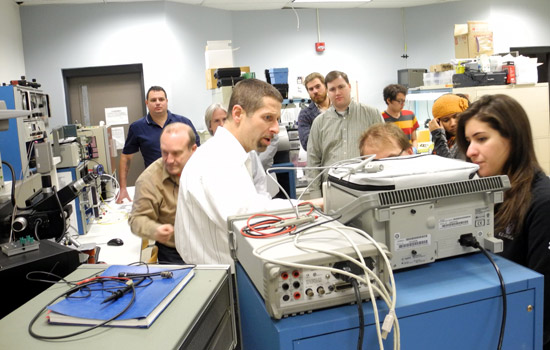RIT hosts photonics, semiconductor training
Microelectronic engineering team leads advanced integrated circuit process training as part of economic development initiatives
Michelle Cometa
RIT engineering faculty members Karl Hirschman, center, and Robert Pearson, left, lead students through wafer testing techniques as part of the weeklong short course in integrated circuit process training. Eleven students from six companies participated.
RIT’s microelectronic engineering faculty took advantage of the university’s intersession break to lead a weeklong training program in integrated circuit process engineering. The training was part of an on-going economic development initiative to support the expansion of the semiconductor workforce and industry, considered one of the nation’s fastest growing sectors.
Eleven engineers and technicians from local and national companies participated in lectures and hands-on laboratory activities at RIT’s Kate Gleason College of Engineering. For some of the students, it was an opportunity to upgrade current technical skills. For others, it was the first time they worked in a clean room, the laboratory and processing facility to develop integrated circuits.
Michael Vergo, a sales engineer from local company Sydor Optics, participated in the intense short course to learn more about semiconductor processing and the equipment, tools and concepts behind it because optics and the semiconductor industry are starting to merge, he said. Many of the engineers he works with are designing electronics using high precision optics, but more are starting to ask about incorporating silicon wafers.
“We’re an optical component manufacturer. We make a lot of glass wafers and substrates,” said Vergo. “It’s not just semiconductors, today, and it’s not just optics. The way technology is driving things much smaller, advanced technologies are using these base processes. So the industries are definitely integrated, and we have to be there.”
Companies are using the RIT training sessions to help prepare their workforce for this merging of processes and to help them enhance services to customers, said Michael Jackson, associate professor of microelectronic engineering and director of outreach for the program. He coordinated the short course and was one of several RIT engineering faculty to conduct the week of classes in topics such as microlithography, masking techniques and etching, several of the key steps and concepts in the overall complex process.
“The companies sought out RIT’s program because of the unique laboratory component to our course,” said Jackson. “There are other institutions or individuals that lecture on these topics, but RIT may be the only institution that enables you to design, build and test your device in the lab.”
Nine of the 11 participants received scholarships from a grant from the U.S. Department of Labor to promote the regional optics industry. The grant is part of the Rochester Regional Photonics Accelerator program that is being coordinated by the Center for Emerging and Innovative Sciences at the University of Rochester. Other RIT scholarships for continuing education under the grant are a course on imaging given by the Chester F. Carlson Center for Imaging Sciences and a course on opto-electronic packaging being given by the Department of Manufacturing and Mechanical Engineering Technology in RIT’s College of Applied Science and Technology.
“You can pick up a book about this, but how far will you get? This training was a chance to have a general background about this technology so I’m not totally out in left field,” Vergo said with a laugh.
Participants at last week’s session came from regional companies such as Sydor Optics, and Thermo-Fisher (Syracuse). Others included representatives from BOSE Corp. (California), Northrop Grumman (Maryland), and Lumiode (Brooklyn).
 Brian Tull, from Lumiode, checks closely the processed wafers completed at the recent integrated circuit process engineering program at RIT. The training, open to regional and national companies, was intended to support growth of the semiconductor workforce and industry. Michelle Cometa
Brian Tull, from Lumiode, checks closely the processed wafers completed at the recent integrated circuit process engineering program at RIT. The training, open to regional and national companies, was intended to support growth of the semiconductor workforce and industry. Michelle Cometa














